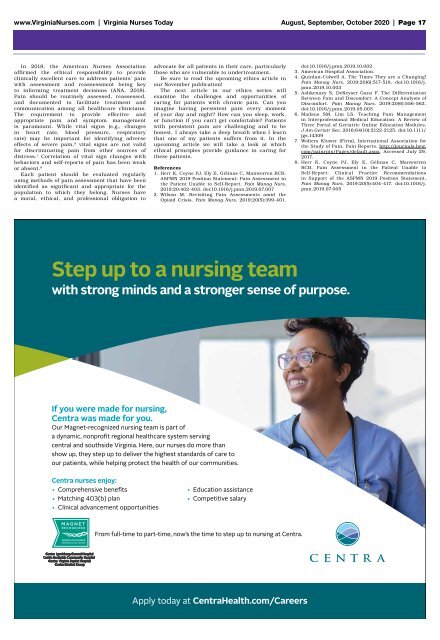Virginia Nurses Today - August 2020
Create successful ePaper yourself
Turn your PDF publications into a flip-book with our unique Google optimized e-Paper software.
www.<strong>Virginia</strong><strong>Nurses</strong>.com | <strong>Virginia</strong> <strong>Nurses</strong> <strong>Today</strong> <strong>August</strong>, September, October <strong>2020</strong> | Page 17<br />
In 2018, the American <strong>Nurses</strong> Association<br />
affirmed the ethical responsibility to provide<br />
clinically excellent care to address patients’ pain<br />
with assessment and reassessment being key<br />
to informing treatment decisions (ANA, 2018).<br />
Pain should be routinely assessed, reassessed,<br />
and documented to facilitate treatment and<br />
communication among all healthcare clinicians.<br />
The requirement to provide effective and<br />
appropriate pain and symptom management<br />
is paramount. While vital signs (e.g., changes<br />
in heart rate, blood pressure, respiratory<br />
rate) may be important for identifying adverse<br />
effects of severe pain, 8 vital signs are not valid<br />
for discriminating pain from other sources of<br />
distress. 1 Correlation of vital sign changes with<br />
behaviors and self-reports of pain has been weak<br />
or absent. 8<br />
Each patient should be evaluated regularly<br />
using methods of pain assessment that have been<br />
identified as significant and appropriate for the<br />
population to which they belong. <strong>Nurses</strong> have<br />
a moral, ethical, and professional obligation to<br />
advocate for all patients in their care, particularly<br />
those who are vulnerable to undertreatment.<br />
Be sure to read the upcoming ethics article in<br />
our November publication!<br />
The next article in our ethics series will<br />
examine the challenges and opportunities of<br />
caring for patients with chronic pain. Can you<br />
imagine having persistent pain every moment<br />
of your day and night? How can you sleep, work,<br />
or function if you can’t get comfortable? Patients<br />
with persistent pain are challenging and to be<br />
honest, I always take a deep breath when I learn<br />
that one of my patients suffers from it. In the<br />
upcoming article we will take a look at which<br />
ethical principles provide guidance in caring for<br />
these patients.<br />
References<br />
1. Herr K, Coyne PJ, Ely E, Gélinas C, Manworren RCB.<br />
ASPMN 2019 Position Statement: Pain Assessment in<br />
the Patient Unable to Self-Report. Pain Manag Nurs.<br />
2019;20:402-403. doi:10.1016/j.pmn.2019.07.007<br />
2. Wilson M. Revisiting Pain Assessments amid the<br />
Opioid Crisis. Pain Manag Nurs. 2019;20(5):399-401.<br />
doi:10.1016/j.pmn.2019.10.002<br />
3. American Hospital Association.<br />
4. Quinlan-Colwell A. The Times They are a Changing!<br />
Pain Manag Nurs. 2019;20(6):517-518. doi:10.1016/j.<br />
pmn.2019.10.003<br />
5. Ashkenazy S, DeKeyser Ganz F. The Differentiation<br />
Between Pain and Discomfort: A Concept Analysis of<br />
Discomfort. Pain Manag Nurs. 2019;20(6):556-562.<br />
doi:10.1016/j.pmn.2019.05.003<br />
6. Madaus SM, Lim LS. Teaching Pain Management<br />
in Interprofessional Medical Education: A Review of<br />
Three Portal of Geriatric Online Education Modules.<br />
J Am Geriatr Soc. 2016;64(10):2122-2125. doi:10.1111/<br />
jgs.14309<br />
7. Wolters Kluwer (Firm), International Association for<br />
the Study of Pain. Pain Reports. http://journals.lww.<br />
com/painrpts/Pages/default.aspx. Accessed July 29,<br />
2017.<br />
8. Herr K, Coyne PJ, Ely E, Gélinas C, Manworren<br />
RCB. Pain Assessment in the Patient Unable to<br />
Self-Report: Clinical Practice Recommendations<br />
in Support of the ASPMN 2019 Position Statement.<br />
Pain Manag Nurs. 2019;20(5):404-417. doi:10.1016/j.<br />
pmn.2019.07.005

















